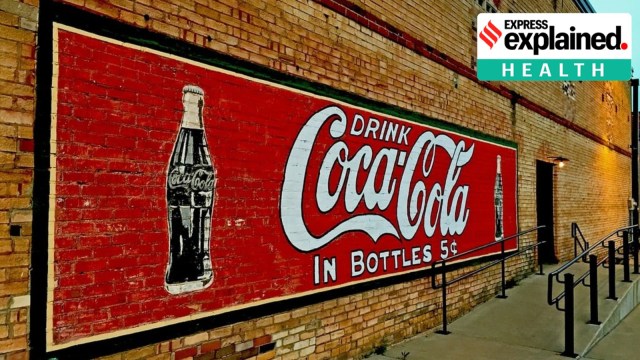Coca-Cola in the United States will now be sweetened with cane sugar instead of high fructose corn syrup (HFCS), US President Donald Trump has claimed. “I have been speaking to Coca-Cola about using REAL Cane Sugar in Coke in the United States, and they have agreed to do so,” Trump posted on Truth Social on Wednesday, adding that cane sugar is “just better!”
While cane sugar and HFCS lead to slightly different products in terms of taste, there is not much evidence suggesting one is healthier than the other. Here’s all you need to know.

What is high fructose corn syrup?
Chemically, HFCS and cane sugar are not very different.
Story continues below this ad
HFCS is derived from corn starch. Corn syrup obtained from corn starch is first broken down into a compound that is 100% glucose. Enzymes are then added to convert some of the glucose to fructose, another type of sugar that is found naturally in fruits.
There are two commonly available types of HFCS: HF42, used for baked goods and canned fruits, comprises 42% fructose and 58% glucose; and HF55, used in sodas and ice creams, comprises 55% fructose and 45% glucose.
Cane sugar is extracted directly from sugarcane, and consists of sucrose molecules — basically one glucose and one fructose molecule bonded together. This makes cane sugar 50% fructose and 50% glucose.
Why is HFCS used for soft drinks in the US?
It’s all about the cost.
Story continues below this ad
Coca-Cola switched from cane sugar to HFCS in the US 41 years ago when the Ronald Reagan administration placed high tariffs and quotas on the import of cane sugar. This led to the price of domestic sugar, grown primarily in Florida, Louisiana, and Texas, spiking — meaning HFCS was 10-30% cheaper than sugar. US policies still limit the import of cane sugar into the country, ostensibly to protect corn farmers, although a majority of American corn is used as animal feed and biofuel.
Following Trump’s announcement, the US Corn Refiners Association said the elimination of HFCS from the US food and beverage supply would cut corn prices by up to 34 cents a bushel (25.4 kg of corn), resulting in a loss of $5.1 billion in farm revenue, Reuters reported.
Moreover, factoring in the current price gap between HF55 and cane sugar and the probability of a large price increase of the latter, some experts estimate that Coca-Cola shifting entirely to HF55 would lead to a “$1billion” cost increase for the company, according to Reuters.
With India being among the top sugar producers in the world, HFCS never took off in the country: most Indian products use cane sugar, also for cost reasons.
Story continues below this ad
Is there a difference in the health impacts of consuming HFCS and cane sugar?
Not really. There was no significant difference in weight, waist circumference, fat mass, cholesterol levels, or blood pressure between those consuming high fructose corn syrup and sugar, according to a 2022 meta analysis from China published in the journal Frontiers in Nutrition.
The only difference that the researchers could pin-point was a higher CRP level in those consuming corn syrup as compared to those consuming sucrose. Higher C-reactive protein or CRP is indicative of inflammation in the body. A high CRP level is associated with a higher risk of heart attack.
The two sweetners are also not very different when it comes to their calorie content — both contain around 4 kcal per gram.
How much sugar is too much?
The World Health Organisation and the Indian Council of Medical Research (ICMR) say that people should restrict sugar consumption to less than 5% of their daily total energy requirement. This comes up to about five teaspoons or 25 g of sugar for normal healthy adults.
Story continues below this ad
The usual soft drink contains more sugar than the recommended daily intake for adults in a single serving. A 300 ml can of Coca-Cola, for instance, contains around 31.8 g of sugar.
“If possible, added sugar may be completely eliminated from one’s diet as it adds no nutritive value other than calories. Calories are healthy only when accompanied by vitamins, minerals, and fibres,” the ICMR’s 2024 guidelines say.
While not as harmful, natural sugars in fruits, vegetables, and dairy products should also be consumed in moderation.
Should people consume colas with artificial sweeteners then?
Doctors recommend against drinking any kind of soft drink, but if someone already consumes them, especially in large quantities, switching over to the ones that use artificial sweeteners may be useful.
Story continues below this ad
The problem, doctors say, is that people tend to drink more colas when they consume the “diet” or “zero calorie” versions, thinking that it is healthy. But in the long run, there can be severe negative consequences, including insulin resistance and diabetes, from consuming too much artificial sweeteners as well.
Artificial sweeteners also taste intensely sweet — much more than normal sugar — which can increase the craving for more sweets. The WHO has recommended against using artificial sweeteners to control weight and prevent lifestyle diseases such as diabetes. The WHO has linked these sweeteners to an increased risk of Type-2 diabetes, cardiovascular diseases, and mortality, in the long run.








































